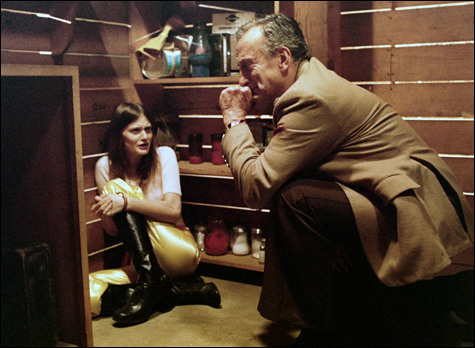
HARDCORE: George Scott transforms himself with alarming ease from a devoutly Calvinist Midwestern businessman into a porn-movie producer. |
| “The Style of Loneliness: A Paul Schrader Retrospective” | Harvard Film Archive: January 30–February 1 |
"I'm not sure what happened to me," says Paul Schrader's Patty Hearst, one of the least reliable of the director's succession of unreliable narrators, in the film named for her. Schrader — the subject of a retrospective this weekend at the Harvard Film Archive — doesn't deal in the kind of Hollywood psychology that explains people's actions in terms of devotion to a clear goal. Avowed motives and causes might do for a short plot description. (Hardcore: a father ventures into LA's sordid underbelly in search of his runaway daughter; Mishima: a famous novelist's obsession with what he sees as modern Japan's loss of honor leads him to commit ceremonial suicide.) But the films contradict such simplifications, taking off at tangents to their ostensible main impulses. Schrader's intellectual complexity sometimes leads to murkiness, but it's also yielded at least one superb film.Schrader will be present at this Friday's screening of MISHIMA: A LIFE IN FOUR CHAPTERS (1985; January 30 at 7 pm), which some consider his masterpiece. Ken Ogata's sober, recessive performance confounds expectations: moments of brazenness, of charm (such as the author's sardonic confrontation with left-wing students occupying a Tokyo University building), keep hinting at an underlying self-denial — more like absence of self than self-hatred — that links Mishima to other Schrader antiheroes. The subtlety of this conception of the character seems an unlikely basis for a feature film, but the idea doesn't have to fill a feature, since Schrader interpolates set pieces based on three Mishima works, each stylized in glowing colors and a theatrical mise-en-scène. Furnished with one of Philip Glass's most maddening scores, Mishima is both a grandiloquent and a circumspect work, in tune with the contradictions of a protagonist forever withdrawing from his own tragedy.

In the entertaining AMERICAN GIGOLO (1980; February 1 at 3 pm), the concluding homage (if that's what it is) to Robert Bresson's sublime Pickpocket is at odds with a movie whose logic is that Richard Gere must be punished for being too adept at trading on his good looks. The skepticism that is the keynote of Schrader's attitude toward Gere's high-priced gigolo results in a film that works as an ironic, disabused takedown of the LA of the period and also as (the embryo of) a dark frame-up thriller but falls short as the account of the redemption that comes the character's way via his affair with a senator's wife (Lauren Hutton). The gliding Steadicam shots and the production design combine with Giorgio Moroder's music to steep the characters in waves of free-floating hostility.
This hostility is as much a part of the Schrader atmosphere as his social criticism, which becomes, from his early films to his later ones, less specific and pointed, more linked to the confusing climate of an obsessive and beleaguered character's private universe. PATTY HEARST (1988; February 1 at 7 pm) depicts the erasure of the kidnapped heiress's amorphous identity and her rebirth as a phony red warrior amid a micro-society of intellectual midgets. (Compared with the Symbionese Liberation Army members in this film, the dimmest of the young Maoists in Jean-Luc Godard's '68-'71 work are on an intellectual par with Antonio Gramsci.) Through canny set design and aggressive camerawork, Schrader transforms the characters' low-priced apartment spaces into distorted mindscapes lit through the rips in window shades. A dark comedy about early-'70s American culture crossed with an avant-garde horror conceit about the manipulation of underfed brains, Patty Hearst is a Pyrrhic victory of a film in which the jubilation of satire gets all damp and constricted amid much psychic heavy weather.
In LIGHT SLEEPER (1991; January 31 at 7 pm, with the director present), a revision of American Gigolo, Schrader uses the same narrative pattern but exchanges LA for Manhattan and upscale hustling for upscale drug dealing. As in American Gigolo, he likes to allude to his thriller plot rather than play its servant — which is fine, but this high-handed sophistication leaves his film high and dry during the inevitable moments when it must exist mainly to forward or wrap up the plot. The performances of Willem Dafoe and Susan Sarandon are so good that one wishes the movie were less sluggish, less mannerist, freer. Some of Schrader's visual ideas are successful: in a shot of a psychic's face reflected in a mirror behind Dafoe as she tries or purports to visualize the fateful forces gathering around him, the compositional tension raises the mystery of the narrative to a peak of ambiguity. But to work, Light Sleeper needed to be a more modest, sleazier film — a Roger Corman or Larry Cohen–type effort — or else a less compromised one, a Wim Wenders–like movie purely about exploration of mood and territory.